
Zavala County is a county located in the U.S. state of Texas. As of the 2020 census, the population was 11,677. Its county seat is Crystal City. The county was created in 1858 and later organized in 1884. Zavala is named for Lorenzo de Zavala, Mexican politician, signer of the Texas Declaration of Independence, and first vice president of the Republic of Texas.

The Daughters of the Republic of Texas (DRT) is a lineal association dedicated to perpetuating the memory of the founding families and soldiers of the Republic of Texas. The Daughters of the Republic of Texas is best known for its former role as caretakers of The Alamo. In early 2015, Texas Land Commissioner George P. Bush officially removed control of the Alamo to the Texas General Land Office. The DRT were also the custodians of the historic French Legation Museum until 2017, which is owned by the State of Texas and is now operated by the Texas Historical Commission. In addition, they operate a museum in Austin on the history of Texas.

Tecoh Municipality is one of 106 municipalities in Yucatán State, Mexico, located 40 km south-east of Mérida, Yucatán. It has a municipal capital of the same name. As of 2003, the city Tecoh had a population of about 8,500 people. Most of the population is Maya. A number of buildings in the town were built atop older Pre-Columbian foundations. "Tecoh" means "Place of the Puma" in the Yucatec Maya language, which is still widely spoken here.

The Wisconsin State Capitol, located in Madison, Wisconsin, houses both chambers of the Wisconsin legislature along with the Wisconsin Supreme Court and the Office of the Governor. Completed in 1917, the building is the fifth to serve as the Wisconsin capitol since the first territorial legislature convened in 1836 and the third building since Wisconsin was granted statehood in 1848. The Wisconsin State Capitol is the tallest building in Madison, a distinction that has been preserved by legislation that prohibits buildings taller than the columns surrounding the dome. The Capitol is located at the southwestern end of the Madison Isthmus. The streets surrounding the building form the Capitol Square, which is home to many restaurants and shops.

The Texas State Capitol is the capitol and seat of government of the American state of Texas. Located in downtown Austin, Texas, the structure houses the offices and chambers of the Texas Legislature and of the Governor of Texas. Designed in 1881 by architect Elijah E. Myers, it was constructed from 1882 to 1888 under the direction of civil engineer Reuben Lindsay Walker. A $75 million underground extension was completed in 1993. The building was added to the National Register of Historic Places in 1970 and recognized as a National Historic Landmark in 1986.
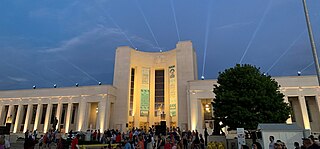
The Hall of State is a building in Dallas's Fair Park that commemorates the history of the U.S. state of Texas and is considered one of the best examples of Art Deco architecture in the state. It was designed and built for the Texas Centennial Exposition.

The Oklahoma State Capitol is the house of government of the U.S. state of Oklahoma. It is the building that houses the Oklahoma Legislature and executive branch offices. It is located along Lincoln Boulevard in Oklahoma City and contains 452,508 square feet of floor area. The present structure includes a dome completed in 2002.

Manuel Lorenzo Justiniano de Zavala y Sánchez, known simply as Lorenzo de Zavala, was a Mexican and later Tejano physician, politician, diplomat and author. Born in Yucatán under Spanish rule, he was closely involved in drafting the constitution for the First Federal Republic of Mexico in 1824 after Mexico won independence from Spain. Years later, he also helped in drafting a constitution for Mexico's rebellious enemy at the time, the Republic of Texas, to secure independence from Mexico in 1836. Zavala was said to have had a keen intellect and was fluent in multiple languages.

The New York State Capitol, the seat of the New York state government, is located in Albany, the capital city of the U.S. state of New York. The capitol building is part of the Empire State Plaza complex on State Street in Capitol Park. Housing the New York State Legislature, the building was completed in 1899 at a cost of US$25 million, making it the most expensive government building of its time. It was listed on the National Register of Historic Places in 1971, then included as a contributing property when the Lafayette Park Historic District was listed in 1978. The New York State Capitol was declared a National Historic Landmark in 1979.

The French Legation is a historic legation building in eastern Austin, Texas, built in 1841 to represent the French government in the new Republic of Texas.
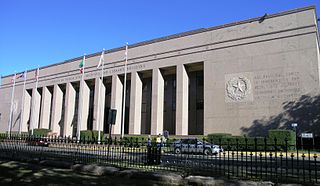
The Texas State Library and Archives Commission (TSLAC) refers to the state government agency in the state of Texas that supports the reading, learning, and historical preservation needs of Texas and its people. The agency is charged with preserving the archival record of Texas, supporting research, and making primary resources available to the public; assisting public, academic, and school libraries across the state in meeting the needs of their communities and students; helping public agencies maintain their public records; and supporting the reading needs of thousands of Texans with disabilities preventing them from reading a standard book.
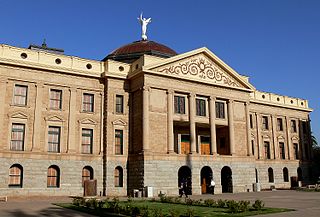
James Riely Gordon was an architect who practiced in San Antonio until 1902 and then in New York City, where he gained national recognition. J. Riely Gordon is best known for his landmark county courthouses, in particular those in Texas. Working during the state's "Golden Age" (1883–1898) of courthouse construction, Gordon saw 18 of his designs erected from 1885 to 1901; today, 12 remain.
Zavala was a town in Jasper County, Texas, United States, founded in 1834. Named for empresario Lorenzo de Zavala, the town was founded on land owned by Thomas Huling and situated along the Angelina River. The approximately 40 families who lived in the town subsisted by farming or logging. The town last appeared on a list of communities in the county in 1878 and has since been abandoned. It is not to be confused with the city of Zavalla, which lies only 20 miles to the northwest, in Angelina County.
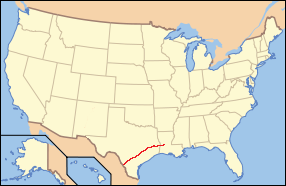
The El Camino Real de los Tejas National Historic Trail is a national historic trail covering the U.S. section of El Camino Real de Los Tejas, a thoroughfare from the 18th-century Spanish colonial era in Spanish Texas, instrumental in the settlement, development, and history of Texas. The National Park Service designated El Camino Real de los Tejas National Historic Trail as a unit in the National Trails System in 2004.

600 Congress is a high-rise office building located at the northwest corner of West 6th Street and Congress Avenue in the Financial District of Downtown Austin, the state capital of Texas. Standing 400 feet tall and containing 32 floors, it is currently the 12th tallest building in Austin, tied with the Four Seasons Residences. The construction of One American Center was completed in 1984 and was developed by Rust Properties. It was the tallest building in Austin until the finishing of the Frost Bank Tower in 2003. In 2017, One American Center was rebranded as 600 Congress.

Granite Mountain is a solid dome, also known as a bornhardt, of pink granite rising over 860 feet one mile west of Marble Falls, Texas. Since quarry operations began in the late 19th century, the distinctive pink-red colored rock has been used in the construction of the Texas State Capitol in Austin, Texas, and also for the construction of the Galveston Seawall. In 1882, three businessmen and the owners of Granite Mountain, G. W. Lacy, N. L. Norton and W. H. Westfall, donated the amount of granite necessary to build the Texas State Capitol. The mountain no longer looks like a geographic feature because of the heavy mining, which has fully covered its surface. A similar but much larger area known as Enchanted Rock State Natural Area can be seen in its undisturbed state west of Marble Falls near Fredericksburg, Texas.
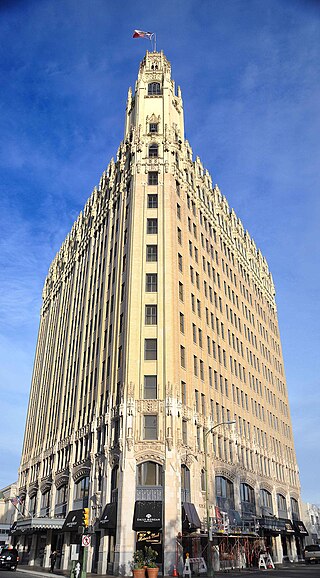
Emily D. West (c.1815–1891), also known as Emily Morgan, is a folk heroine whose legendary activities during the Texas Revolution have come to be identified with the song "The Yellow Rose of Texas".

Adina Emilia De Zavala was an American teacher, historian and preservationist of Texas history. Her efforts led to saving the Alamo Long Barrack Fortress for future generations. She was born to Augustine De Zavala, son of Lorenzo de Zavala, the first Vice President of the Republic of Texas. Adina's mother Julia Tyrrell De Zavala was born in Ireland. In 1994, Recorded Texas Historic Landmark Marker number 86 was placed at Alamo Plaza to honor De Zavala. In 2008, Texas Historical marker number 15124 was placed in St. Mary's Cemetery to honor De Zavala's contributions to Texas.

The architectural structures of Fredericksburg, Texas are often unique to the Texas Hill Country, and are historical edifices of the German immigrants who settled the area in the 19th Century. Many of the structures have historic designations on a state or national level. The Gillespie County Historical Society is actively involved in assisting with preservation.

Waters Park was a village located eight miles north of downtown Austin, Texas defined by the boundaries of Farm to Market Road 1325, MoPac, and the Southern Pacific Railroad. It is now part of the City of Austin.




















